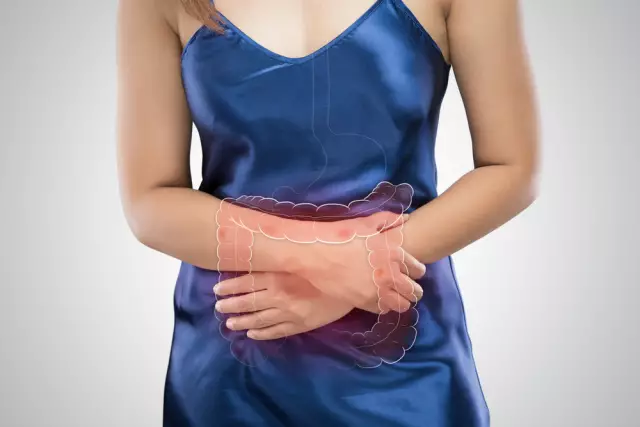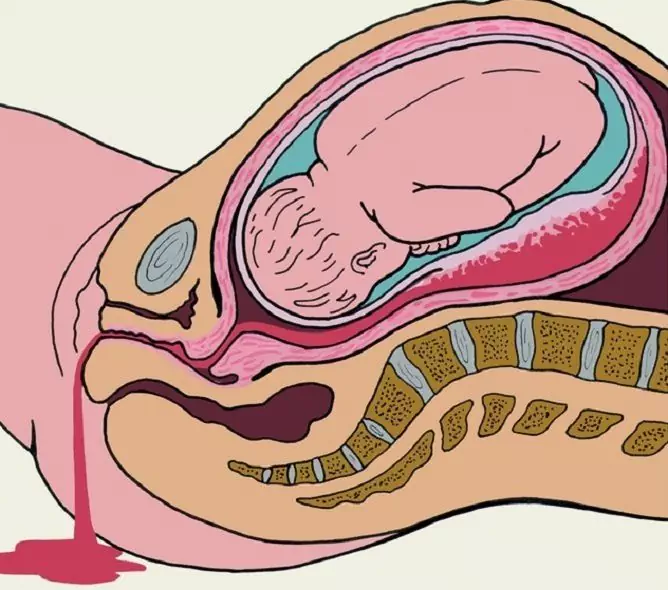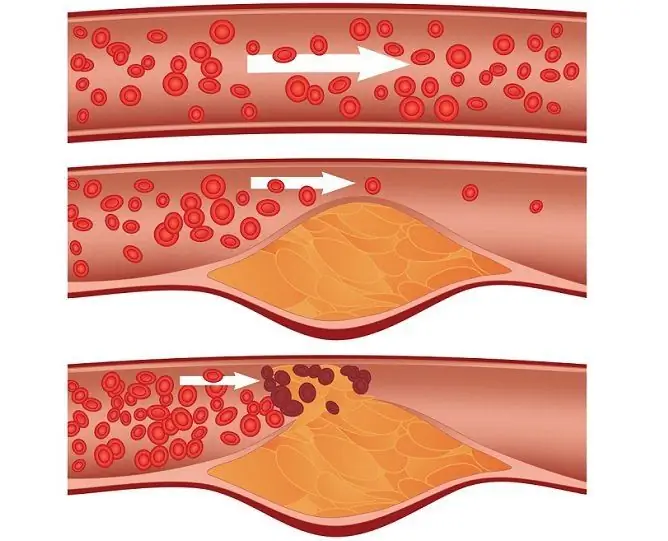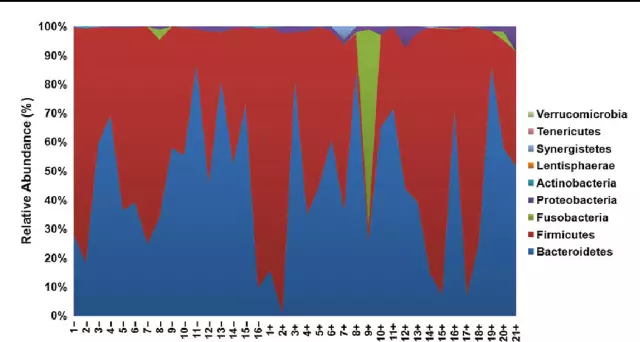- Author Rachel Wainwright [email protected].
- Public 2023-12-15 07:39.
- Last modified 2025-11-02 20:14.
Intestinal obstruction
Intestinal obstruction consists in partial or complete cessation of the movement of the contents (chyme) through the intestine. Intestinal obstruction requires urgent medical intervention, since it is a life-threatening condition.
Types and causes of intestinal obstruction

By the nature of the course, acute intestinal obstruction and chronic obstruction are distinguished, and intestinal obstruction can also be complete or partial.
The origin can be congenital or acquired. Congenital intestinal obstruction in children is caused by abnormalities in the development of the intestine or its blockage with dense meconium - the feces formed during intrauterine development of the fetus.
Depending on the cause that caused it, intestinal obstruction is divided into two types: dynamic and mechanical.
Dynamic intestinal obstruction is caused by disorders of the innervation and blood circulation in the intestine.
In turn, it is divided into the following forms:
- Paralytic intestinal obstruction. It occurs as a result of paralysis of the muscular layer of the intestine, due to which peristalsis stops - the movements that move the chyme along the intestine. It is a complication of peritonitis (inflammation of the peritoneum). Paresis (partial paralysis) of the intestine occurs in renal and biliary colic, acute attacks of pancreatitis, pelvic, spinal and abdominal hematomas, and can also be postoperative;
- Spastic intestinal obstruction. The cause of spastic intestinal obstruction is intestinal spasm as a result of poisoning with certain drugs and heavy metal salts.
Mechanical intestinal obstruction is the most common type of intestinal obstruction. It is divided into the following subspecies:
- Obstructive intestinal obstruction. It occurs in the presence of a neoplasm that partially or completely overlaps the intestinal lumen (fecal stones, tumors, cysts, worms), it is characterized by a gradual increase in symptoms;
- Strangulated intestinal obstruction. It is associated with compression or infringement of the mesentery of the intestine (volvulus, intestinal nodes), this type is characterized by rapid development, 4-6 hours from the moment of onset to complete obstruction;
- Mixed or combined intestinal obstruction. Occurs with intussusception, when the intestinal lumen is clogged by the intruding other intestine, while the mesentery of the intruding loop is compressed. Intussusception is the most common cause of intestinal obstruction in children.
Intestinal obstruction is also classified by level:
- Small intestinal obstruction;
- Large intestinal obstruction;
- High intestinal obstruction;
- Low intestinal obstruction.
Intestinal obstruction symptoms
For each type of intestinal obstruction, the symptoms are different, but there are signs that are common to all cases:
- The appearance of a sharp pain in the abdomen;
- The appearance of vomiting;
- Stopping gas and stool retention.

These three symptoms of intestinal obstruction have features characteristic of this condition, so it is worth talking about them in more detail.
- Pain. Has a cramping character, painful contractions coincide with the rhythm of peristalsis. At the initial stage, in the inter-pain interval, the patient may not be bothered at all, or a weak aching dull pain may remain. During an attack, the pain becomes so intense that patients rush about, trying to find a position in which it would decrease. At the peak of pain, the patient can neither scream nor speak, and one of the characteristic symptoms of intestinal obstruction is a quiet moan (ileus moan). At this time, cold sweat appears, the pulse quickens - signs of painful shock appear.
- Vomiting. In case of small intestinal obstruction, repeated, exhausting, abundant, not bringing relief, at first containing the remnants of undigested food, then consisting of intestinal juices with an admixture of bile. In the next period, with the addition of peritonitis, painful vomiting occurs with stagnant contents of the lower parts of the intestine, which has the appearance and smell of feces - "fecal vomiting". With a large intestinal obstruction, vomiting can be no more than one or two times, while fecal vomiting is not observed.
- The symptoms of stool retention and gas discharge also vary depending on the form of the disease. With low or large intestinal obstruction, stool and gas may be completely absent for several days before the onset of acute intestinal obstruction. But with high, or small intestinal obstruction at the initial stage, there may be independent stool, or stool caused by an enema. In this case, the absence of stool and gas formation may already be late symptoms of intestinal obstruction.
The rest of the symptoms of intestinal obstruction include: thirst, distended abdomen, increased peristalsis at the onset of the disease, and its complete cessation as the condition worsens. At the beginning of the disease, due to strong peristalsis, loud intestinal noises are heard, then the peristalsis stops, and complete silence sets in - a symptom of "deathly silence".
During acute intestinal obstruction, three stages are distinguished:
- The initial, or "ileus groan" period, lasts from 2 to 12 hours. It is characterized by pain syndrome, bloating, increased peristalsis;
- Intermediate, 12 to 36 hours. The pain stops altogether, or loses its paroxysmal and intensity, which is why this stage is called the stage of imaginary well-being. Dehydration and intoxication are increasing. Peristalsis stops;
- Terminal, or late. Comes 36 hours after the first signs of acute intestinal obstruction appear. At this stage, the patient's condition is significantly aggravated, the failure of all life-supporting systems of the body sets in.
Diagnosis of intestinal obstruction
Diagnosis of acute intestinal obstruction should be prompt. The initial diagnosis is made on the basis of a thorough examination, identification of characteristic symptoms and samples, and also on the basis of X-ray examination.
Intestinal obstruction treatment
Treatment of intestinal obstruction begins with emergency measures to replenish lost fluid and relieve pain shock. The upper sections of the gastrointestinal tract are freed from the remains of the contents using a probe, the lower sections - using siphon enemas. To stop increased peristalsis at the initial stage, antispasmodics are administered, which relax the muscle wall. Sometimes, for the treatment of dynamic bowel obstruction, these measures are sufficient to restore normal bowel function.
If the therapeutic methods of treating intestinal obstruction in its dynamic form are ineffective, and in all cases of mechanical intestinal obstruction, they resort to surgical intervention, which consists in eliminating the cause of the disease, in the case of necrosis of the intestinal area - its excision and restoration of intestinal patency.
YouTube video related to the article:
The information is generalized and provided for informational purposes only. At the first sign of illness, see your doctor. Self-medication is hazardous to health!






